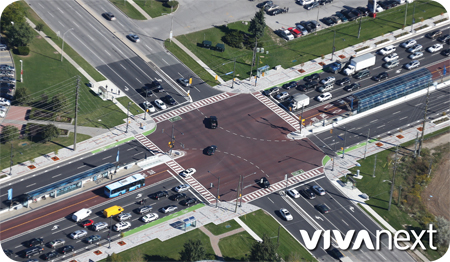You probably know where we’re going with this. It’s not simple to design and build a major transportation project, but we’re getting better and better at it.
It starts with a consistent vision of a transit system that matches plans for the future by the Province and the Region. A plan for making the vision a reality comes next, as dedicated lanes for Bus Rapid Transit – rapidways – connecting York Region’s key urban centres. It’s more than transit though, with designs including updated infrastructure and pedestrian-friendly, attractive surroundings. The 34 kilometres of rapidway and 37 vivastations are divided into design-build projects, based on funding and logistics. Closing roads entirely isn’t an option, so construction timelines are longer to allow for keeping lanes open as much as possible, and projects are staggered so that there isn’t too much work being done, all at once.
We select a contractor through a competitive bidding process. This is an important point in the project, because what is or isn’t included in the contract can impact the timing or costs of a project at a later point. We have highly-skilled engineering, construction and procurement professionals whose advice ensures we procure the project accurately and fairly. Even so, there are an enormous amount of details to consider, and every aspect needs careful thought. The procurement of each project has been tailored to its particular circumstances, and has improved on the project before it.
For the first rapidway project, Highway 7 East, the utility work and the design-build of the project were each coordinated by a separate contractor at the same time. The intention was for a quick build, but it was a challenge for two separate contractors to schedule intertwined work in the same locations.
For the next two projects, Davis Drive and Highway 7 West [Interchange Way to Bowes Road], the same contractor coordinated the utility work and built the project. This helped the contractor to schedule the work, although there were still unexpected elements underground to deal with, as is the case with most construction projects. The contract for the latter project, Highway 7 West, also included more requirements for utility coordination and recognition of timelines needed for permits and relocating utilities.
We recently procured the contractor for the rapidway on Yonge Street, and even more was done to ensure the project runs smoothly. A Subsurface Utility Engineering [SUE] study was fully completed before we even issued the RFP, and the results of the study gave bidders a better understanding of the existing infrastructure, preparing them for the utility work included in the contract. As with the Highway 7 West contract, timelines allowed for permits and utility relocation, and in this case they were fully scheduled. A requirement was also added for an Independent Quality Certifier [IQC] to make it easier to monitor and audit quality of work – previously this was a combined effort.
So building it isn’t simple, but each project has helped improve the next, and we’ve already built and put into service 11 vivastations and 6 kilometres of rapidway. Each project has unique features and challenges, but the end results are worth it… we hope you have tried the improved service on Highway 7 East, as Viva now travels in its own dedicated lane!

